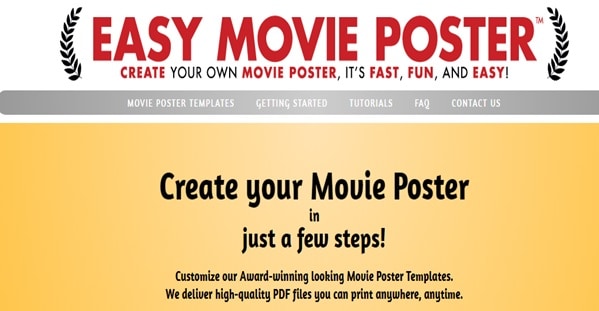Unleashing Creativity: The Future of Movie Posters with AI Generators
Unleashing Creativity: The Future of Movie Posters with AI Generators
Blog Article

In an age where technology continuously transforms the landscape of creativity, the world of movie posters is no exception. The advent of AI has introduced innovative tools that can generate captivating visuals, pushing the boundaries of traditional design. Movie posters serve as the first impression for audiences, encapsulating the essence of a film and drawing viewers in. With the rise of AI movie poster generators, filmmakers and marketing teams are discovering new ways to create eye-catching designs that resonate with diverse audiences.
As these AI-driven tools evolve, they offer filmmakers the opportunity to experiment with unique styles and themes that may not have been possible with conventional methods. By harnessing the power of AI, creators can quickly produce numerous design iterations and explore creative directions previously limited by time and resource constraints. The future of movie poster design is becoming increasingly collaborative, blending human creativity with artificial intelligence to unleash a new wave of visual expression in the film industry.
The Rise of AI in Graphic Design
In recent years, artificial intelligence has made significant strides in various creative domains, and graphic design is no exception. Tools driven by AI assist designers in generating aesthetic visuals, streamlining workflows, and enhancing creativity. The integration of AI into graphic design has transformed traditional practices, allowing for rapid prototyping and the exploration of countless styles and concepts in a fraction of the time it would take manually.
One area where AI has started to shine is in the creation of promotional materials, particularly movie posters. With the emergence of AI movie poster generators, filmmakers and marketers can easily produce high-quality designs tailored to their specific needs. These generators can analyze existing posters, identify trends, and blend various elements to craft unique visuals that resonate with target audiences, making the design process more accessible and efficient.
As technology continues to evolve, the capabilities of AI in graphic design will expand, opening up new possibilities for artists and marketers alike. The future of movie posters seems particularly bright, as AI movie poster generators not only enhance creativity but also democratize the design process for indie filmmakers and studios with limited resources. This shift is set to redefine how visual storytelling is approached in the film industry.
Transforming Aesthetic Appeal: AI in Movie Posters
The integration of AI in the creation of movie posters has revolutionized the visual landscape of film marketing. By harnessing sophisticated algorithms, AI movie poster generators can analyze existing designs, trends, and audience preferences to produce visually captivating artwork. This innovation enables filmmakers and marketers to explore diverse styles and concepts that resonate with target demographics, ensuring that the posters not only capture attention but also reflect the essence of the film.
One of the most significant advantages of AI in poster design is its ability to streamline the creative process. Designers can input specific parameters such as genre, themes, and color palettes, allowing the AI to generate multiple variations in a fraction of the time it would take a human artist. This rapid iteration fosters collaboration between human creativity and machine efficiency, leading to striking visuals that may not have been conceived through traditional methods. As a result, filmmakers can experiment with different aesthetics and select the designs that best encapsulate their vision.
Moreover, AI eliminates some of the subjective biases that can cloud the evaluation of art. By relying on data-driven insights and audience reactions, AI movie poster generators can produce designs that are more likely to engage viewers. This objective approach to aesthetics not only enhances the appeal of movie posters but also aligns them more closely with audience expectations. Ultimately, the fusion of AI technology and creative design is paving the way for a new era in movie promotion, where eye-catching visuals are just a click away.
Join Now
Future Trends: Innovations in AI-Generated Art
As technology continues to advance, the realm of AI-generated art is experiencing exciting innovations that are reshaping the creative landscape. One significant trend is the integration of machine learning algorithms that can analyze vast amounts of visual data. This allows AI movie poster generators to not only create visually striking designs but also tailor them to align with audience preferences and emerging cinematic trends. By studying the elements that resonate with viewers, these tools can produce artwork that is more likely to capture attention and drive interest.
Moreover, the collaboration between artists and AI is becoming more prevalent. Many creatives are leveraging AI movie poster generators as a source of inspiration rather than solely a tool for production. By blending their artistic vision with the capabilities of AI, designers can explore innovative styles and concepts that might not previously have been considered. This synergy between human intuition and machine learning is likely to lead to groundbreaking designs that push the boundaries of traditional movie marketing.
Lastly, personalization is set to become a key feature of AI-generated art. Future developments in AI technology will enable movie poster generators to create customized posters based on individual viewer preferences and behaviors. This level of personalization can enhance audience engagement, as movie posters will not just serve as promotional tools but tailored artworks that resonate on a personal level. As these trends unfold, the future of movie posters will be a dynamic interplay of creativity, technology, and individual expression.
Report this page